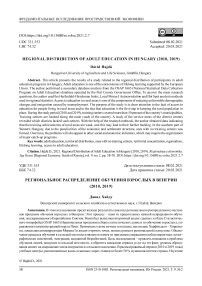Regional distribution of adult education in Hungary (2010, 2019)
Автор: Dávid Hajdú
Журнал: Региональная экономика. Юг России @re-volsu
Рубрика: Фундаментальные исследования пространственной экономики
Статья в выпуске: 2 т.9, 2021 года.
Бесплатный доступ
This article presents the results of a study related to the regional distribution of participants in adult education programs in Hungary. Adult education is one of the cornerstones of lifelong learning supported by the European Union. The author performed a secondary database analysis from the OSAP 1665 (National Statistical Data Collection Program on Adult Education) database operated by the Pest County Government Office. To answer the main research questions, the author used the Herfindahl-Hirschman Index, Local Moran I Autocorrelation and Hot Spot analysis methods used in regional statistics. Access to education in rural areas is one of the components of reducing unfavorable demographic changes and emigration caused by unemployment. The purpose of the study is to draw attention to the lack of access to education for people living in rural areas and to the fact that education is the first step in keeping the rural population in place. During the study period (2010 and 2019), training centers covered more than 50 percent of the country’s municipalities. Training centers are located along the main roads of the country. A study of the service areas of the district centers revealed which districts lacked such centers. With the help of the research methods, the author obtained data indicating that the training achievements of rural areas are weak, and this may lead to their further backlog. In the southern part of Western Hungary, due to the peculiarities of the economic and settlement structure, area with no training centers was formed. Over time, the problems will also appear in other social and economic indicators, which may require the organization of major catch-up programs
Adult education, territorial distribution, area with no training centers, territorial concentration, regionalism, lifelong learning, access to adult education
Короткий адрес: https://sciup.org/149135752
IDR: 149135752 | УДК: 331.553 | DOI: 10.15688/re.volsu.2021.2.7
Текст научной статьи Regional distribution of adult education in Hungary (2010, 2019)
DOI:
The fact is that the adult training, including higher education adult training, has undergone significant change since the end of the 20th century. The role of adult education used to be a kind of compensation - namely, to exclude them from the unjust education system due to economic or social reasons to enable them to obtain a higher level of education. Typically, it has played such a role in Europe for a long time, especially in those parts of Europe where totalitarian regimes have emerged in the name of social justice (before the Second World War in the fascist and after the Second World War in the Communist regimes). In the case of the United States, such a role was given to adult education, partly in the early 1930s, connection with Roosevelt’s New Deal, and partly in the 1960s, under the Johnson Great Society program [Kozma, 2000: 64]. I would add that this substitute role still exists in societies with a high level of immigration. However, this substitute, justifying role of adult education is visibly dwarfed, relegated to the present day. This changed role of adult education in the late 1990s is characterized by the predominance of tertiary education. Adult education is increasingly attended by more educated social groups - and less educated by fewer. Adult education does not make up for the gaps in education, but continues and complements it [Kozma, 2000: 70]. Let us add that in developed, richer countries, in addition to vocational training, “recreational” training, “learning-entertainment” and the consumption of education play an increasingly important role in higher education. It is clear that higher education is beginning to become the same consumer good as leisure, reading, or entertainment [Polónyi, 2019].
Adult training includes a complex of education and training focused on the formation of personality abilities and skills, and the activity aimed at the purposeful and planned development of adults, in which the development of specific competencies is emphasized. In a narrow sense, adult education is the vocational training, further training and retraining of adults, usually which also offers an officially recognized qualification [Benedek, Csoma, Harangi, 2002: 163].
There are three basic categories of purposeful learning activities. Formal learning takes place in basic education and training institutions and ends with a recognized diploma or vocational qualification. Non-formal learning takes place alongside systems for basic education and training and usually does not end with an official certificate [Polónyi, 2018]. The workplace is a possible arena for non-formal learning, but it can also be implemented through the activities of civil society organizations and groups (eg. youth organizations, trade unions, political parties). It can also be implemented through organizations or services (eg fine arts, music courses, sports education, or private exam preparation) that have been set up to complement formal systems [Tóth, 2017]. Informal learning is a natural part of everyday life. Unlike formal and non-formal forms of learning, informal learning is not necessarily a conscious learning activity and it is possible that those involved do not recognize the increase in their knowledge and skills themselves [Európai Bizottság, 2000].
The concept of adult education is complex, -according to the Adult Education Act - we include general, language and vocational education [Zachár, 2009]. The legislation distinguishes 4 training circles in Hungary today, these are the following:
– training circle “A”: professional trainings according to OKJ (National Training List);
– training circle “B”: other professional trainings are allowed. In the wording of the Adult Education Act, other vocational training is training aimed at obtaining a non-state-recognized vocational qualification, which is aimed at acquiring and developing the competence necessary for the performance of a profession, position or work activity and non-official training [2013. évi LXXVII ...];
-
– training circle “C”: language courses allowed;
– training circle “D”: other trainings are allowed. In the wording of the Adult Education Act, other training is training aimed at increasing general education, developing competencies that cannot be linked to a qualified vocational qualification, professional qualification or language qualification, contributing to the development of adult personality, social equality and civic competence [2013. évi LXXVII ...].
There are several areas of adult education, such as:
-
– adult education in the school system, which is aimed at obtaining a general, secondary or higher education and / or professional qualification, the legal regulation of which is contained in the Public Education Act and the Higher Education Act [Benedek-Lőrincz, 2016];
-
– training outside the school system, the largest area of which is labor market training; the legal regulation of training outside the school system is basically contained in the Adult Education Act, the basic legislation of vocational training is contained in the Vocational Training Act and its regulations, the legal background of supported training supported by the Employment Act [Farkas, 2019];
-
– the purpose of labor market training is to facilitate the employment (placement) of an individual or the retention of his or her job; this objective can generally be achieved through the acquisition of job-recognized or non-state-recognized vocational qualifications, whether for employment or training; emphasize that the definition of the specializations of labor market training and the vocational qualifications to be acquired must be based on economic needs [Lakner, 2016];
– the vocational training function of adult education is also linked to general and language training, which, in addition to extensive activities in the field of public education, is defined by the Adult Education Act of 2001 as a separate area of adult education; the importance of general and language training is given on the one hand by its function of establishing and enabling vocational training, and on the other hand by strengthening the position of the adult worker. (Demands for the latter are increasing, such as the acquisition of job search skills and “techniques” and language learning) [Zachár, 2003].
According to the theory of human capital, the best-known theorist of which is Theodore W. Schultz, human knowledge, which is crucial in the economic role of the workforce, is the result of a long, costly process most similar to the investment process. means [Schultz, 1983: 48]. The theory is that such investment in human capital explains most of the increase in real income per worker. According to Schultz, there are five main categories of human capacity building activities: 1) health facilities and services that affect people’s longevity, strength, endurance, vitality, and viability; 2) on-the-job training; 3) formal, organized, elementary, secondary and higher education; 4) adult education programs; and 5) the migration of individuals and families to adapt to changing job opportunities [Schultz, 1983: 60]. Thus, the productivity-enhancing and wageincreasing role of adult education is a fundamental theory of mainstream economics, as are the externalities of education [McMahon, 2000], which are related to social benefits. At the same time, there are quite different opinions in the literature about the rate of return on adult education. According to some literature [Heckman, Masterov, 2007; Heckman, 2011], the return on adult learning is lower than that on school learning.
Material and method
As a basis for the secondary research, I reviewed the available domestic and international textbooks and journal articles on the topic. After getting to know them, I studied and downloaded the data of the Central Statistical Office, the National Employment Service and the databases available on the OSAP 1665 Statistical interface. The analysis was performed for the settlements of Hungary on the absolute number of participants in adult education, their unemployment data and its resident population. For spatial analysis of the calculated statistical data and mapping of the obtained results ArcGIS 10.6.1. I used GIS software.
The spatial structure peculiarities of Hungary are shaped by the distance from the economic center of the EU (the so-called West-East slope), the size and hierarchy level of the settlements, and the centerperiphery relationship system formed due to longer-term development anomalies. In the most favorable position is the centrally located metropolitan agglomeration, which is highly concentrated in higher level resources. The economic and social indicators of the county capitals already show a more diverse picture according to their location. The western half of the country is characterized by more favorable labor market conditions, due to which the data of small towns are better than those of the regional centers of Eastern Hungary [Koncz, Szűcs, Nagyné Demeter, 2018]. In terms of settlement network, the southern part of Western Hungary and the eastern part of Northern Hungary are characterized by the dominance of small villages, which makes it difficult to spatially organize the service sector, compared to Central Hungary and the southern part of Eastern Hungary.
In the first step, I used the Herfindahl – Hirschman Index ( HHI ) to measure the spatial distribution of adult education. I calculated the HHI for the adult education indicators of the studied area and applied the method. The Herfindahl- Hirschman index is the degree of concentration of between a naturalistic variable area unit (eg. Settlement, district, county, region) [Koncz, Szűcs, 2017].
n
HHI = У VL (1)
i = 1
where n is the number of elements, Vmi is the area fraction of the i -th natural variable. The index decreases with equalization of the spatial concentration of the studied variable and reaches its minimum value when the studied phenomenon is evenly distributed among the territorial units. Maximum value when the phenomenon is concentrated in one area. The minimum of the indicator depends on the development of the number of elements [Komarek, 2012]. Given that the HHI data from the above formula took very small values, in my dissertation I reported the square value of a hundred times the ratio of the indicators included in the calculation for the sake of easier interpretation. In our case, the number of examined elements is n = 3155, the corresponding minimum HHI , ie the value belonging to a completely uniform distribution: 0.001005.
For some data obtained from secondary sources, I performed a spatial autocorrelation study using Local Moran statistics to explore the spatial correlation system.
nn
УУ 5 ч ( У1 - y )( y .i - y )
n i = 1 j = 1
An
У ( y , - y ) i = 1
where n is the number of area units, yi and yj are the values of the examined variable in each area unit, y is the arithmetic mean of the examined indicator, A is the number of neighborhood relationships, and the value of δij is 1 if i and j are adjacent, otherwise n is indicates the number of items [Tóth, 2014]. If I > –1 / n – 1, then the autocorrelation relationship is positive, if I < – 1 / n – 1, then the autocorrelation relationship is negative. If I = –1 / n – 1, there is no autocorrelation relationship between the individual territorial units [Egri, 2017].
To describe the spatial patterns, I used the local test function of spatial autocorrelation, the univariate Local Moran I method developed by Anselin in 1995. This method is suitable for detecting areas that are similar or different from their neighbors [Tóth, 2014: 62]. The formula for Local Moran I is:
Iu =--„ [?][?][?l ^ j,i, (3) where zi , t and zj , t are the standardized values of the observation units at time t. For a univariate Local Moran, zi , t , and zj , t refer to the same database. Wij is the area weight matrix [Anselin, 1995]. The obtained result classifies the settlements into four groups:
-
1. High to high (HH): high value territorial units for which the neighborhood also has a high value,
-
2. High-low (HL): units with a high value for which the neighborhood has a low value,
-
3. Low to low (LL): low value areas where the neighborhood also has a low value,
-
4. Low – high (LH): territorial units with a low value, in which case the neighborhood has a high value [Tóth, 2014; Egri, 2017].
I determined the significance filter of the local Moran below 0.05 and the number of permutations in 499.
Results
In Hungary, persons of compulsory school age (16 years) can participate in adult education without an upper age limit. In the country, adult education is a relatively new form of education. Participation is influenced by a number of factors, such as age, form of funding and availability. In the two years studied, in 2010, most of the 30-39 age group participated in the trainings and there were no participants over the age of 60 in any of the adult education courses. In 2019, then 300,000 people from the 40-49 age cohort participated, further strengthening the idea of lifelong learning. This year, the 60-64 age group and the over 65 age group appeared in adult education, covering 5.2% of all educated people. The analysis showed that in both years studied, women were in the majority among those in adult education. In both 2010 and 2019, they reached a rate of 52% (Fig. 1).
In Hungary, comparing the two examined years, there was an increase, both in terms of training locations and participants in training. Of the 3,155 settlements in the country, the number of settlements affected by adult education was 978 in 2010, while in 2019 training was provided in 1,661 settlements. The number of participants in the trainings increased by 60.9%. In 2010, 649,576 people participated in adult education, while in 2019, 1,045,289 people.
The predominance of Budapest appeared in both examined years, in 2010 38.47% of the educated, while in 2019 34.35% of the participants in the training were concentrated in the capital, ie it shows a decrease. The concentration of adult education in county capitals was 70.2% in 2010, which showed a low decrease to 64.5% by 2019, ie two-thirds of those participating in adult education are currently concentrated in county capitals. Among the county seats, in 2010 and 2019 the centers of Borsod-Abaúj-Zemplén, Hajdú-Bihar and Győr-Moson-Sopron counties also had the highest number of participants. The three cities have completely different social and economic indicators. Due to its relatively high unemployment, Borsod-Abaúj-Zemplén County, which is traditionally an industrial county, had the highest number of participants due to the trainings supported by the European Union. In contrast, in the case of Hajdú-Bihar county and Győr-Moson-Sopron county, employer-funded trainings were predominant. Examining the concentration of adult education in district centers, in 2010 89.7% of all participants in adult education, while in 2019, 82.7% were concentrated in district centers. In the country, the participation rate of trainings in rural, backward areas ranged from 10 to 18% in the two years studied (see Fig. 2).
In Hungary, the number of settlements affecting adult education increased exponentially in the period under review. Figure 3 also shows well that in 2019, trainings were available in most settlements in the central and eastern part of the country.
In 2010, the training locations were even more focused on the county capitals and district centers, but 10 years later the involvement of rural areas in the adult education system has already started. In 2010, the training sites were mostly accessible along the main roads, while in 2019 their accessibility became more open. If we look at the figure below, it is definitely outlined in Borsod-Abaúj-Zemplén county as well, the main roads starting from the county seat (Miskolc) in the direction of Slovakia almost completely cover the adult education sites. The western part of the country was less plentiful with places to access training, but it can be said that all county capitals and district centers in the country had adult training. In terms of accessibility, small-village settlements and lagging areas were not involved in training, thus further worsening their previous disadvantage.
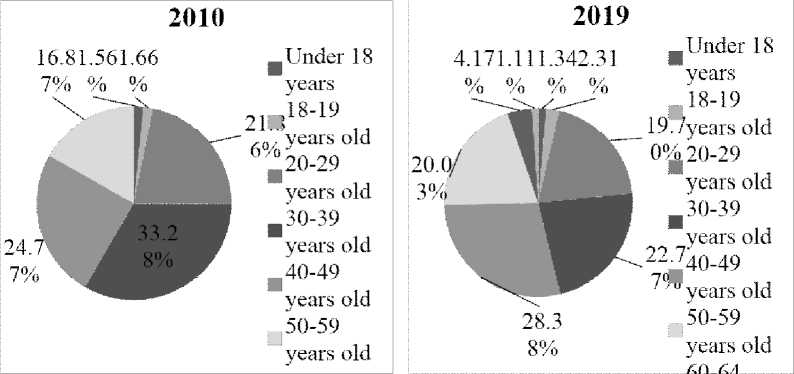
Fig. 1. Distribution of adult training participants by age group in Hungary (2010, 2019) Note. Compiled by the author based on: [OSAP 1665 ...].
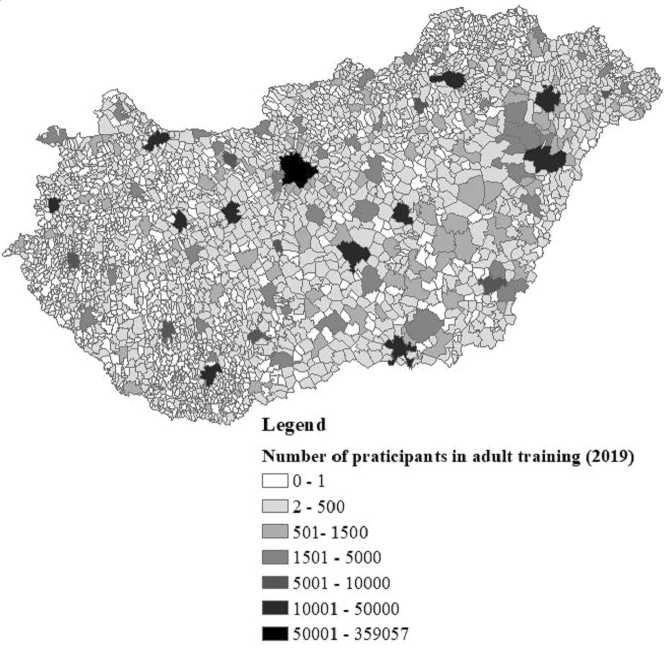
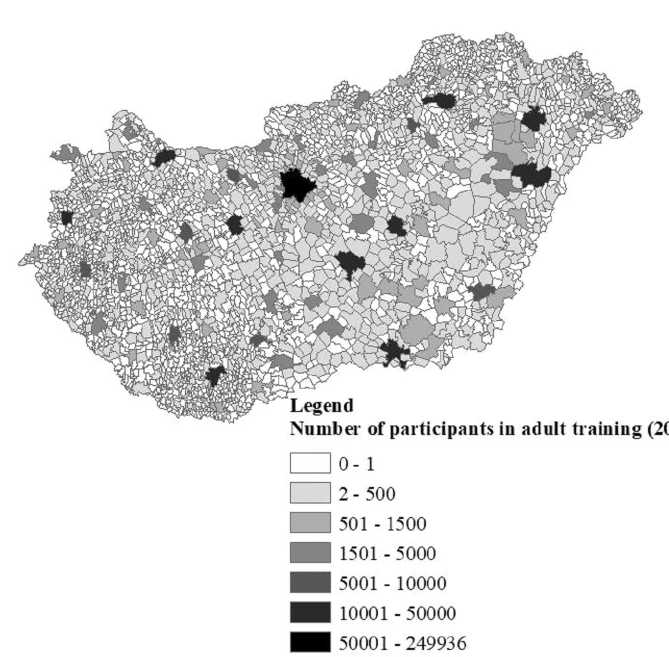
Fig. 2. Territorial distribution of adult training participants in Hungary (2010, 2019)
Note. Compiled by the author based on: [OSAP 1665 ...].
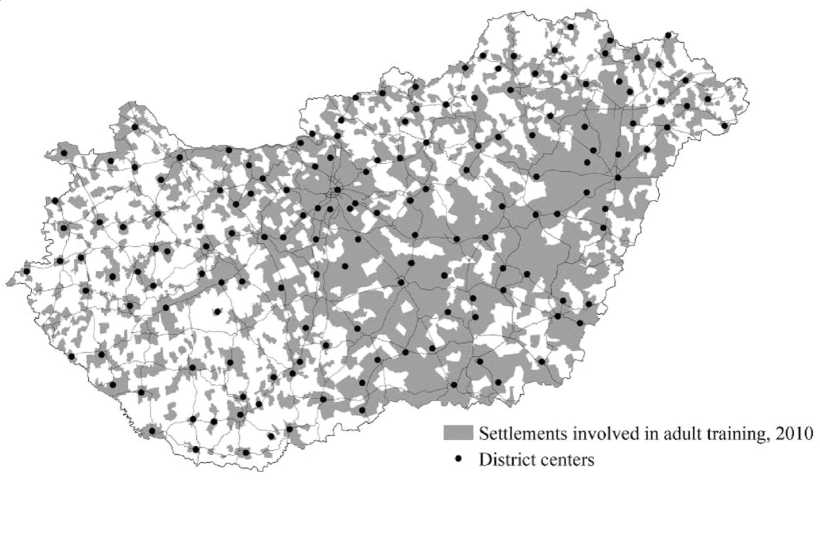
^1 Settlements involved in adult training, 2010 • District centers
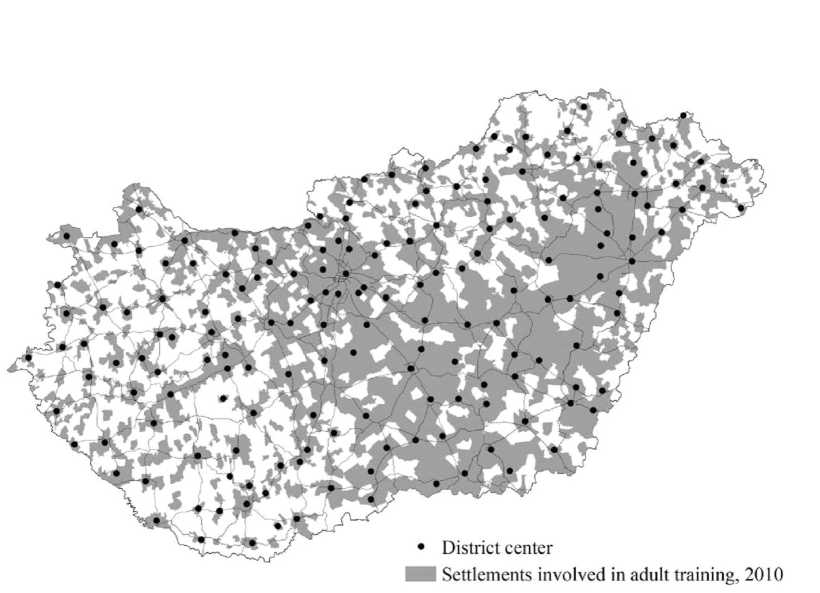
• District center
^1 Settlements involved in adult training, 2010
Fig. 3. Availability of adult training in Hungary (2010, 2019)
Note. Compiled by the author based on: [OSAP 1665 ...].
I set the catchment area of the district centers to 12 km, because the mobility of the Hungarian people is low and in a previous questionnaire survey I got this distance that they are willing to travel a maximum of 12 kilometers on average to complete a new training [Hajdú, Koncz, 2020]. Examining the absorption capacity of district centers for adult education, the most lagging areas in terms of access to adult education in the country were identified. These areas are mostly located on the outskirts of the country, in border areas. In the central and eastern part of the country, the largest untrained area is located in Borsod-Abaúj-Zemplén County along the Slovak border. As Figure 3 illustrated, adult education sites were found in the vicinity of the main roads. The border areas are characterized by settlements with high unemployment, relatively low employment and high public employment, where they could be reduced by organizing adult education locally in order to prevent and reduce high emigration. In the western part of the country, south of Lake Balaton, an untrained corridor developed in both years. This corridor showing adult education gaps affected six counties in the southern and western part of the country, and from east to west it affected Bács-Kiskun county, Tolna county, Baranya county, Somogy county, Zala county and the south-western part of Vas county (Fig. 4).
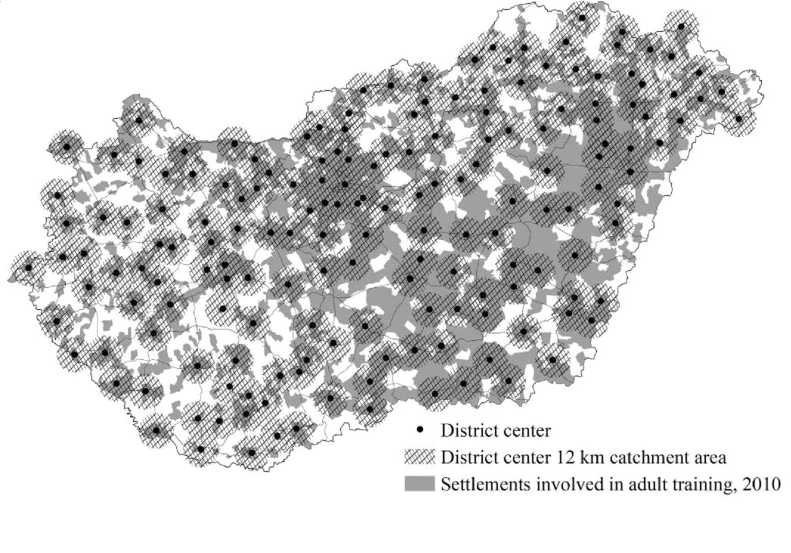
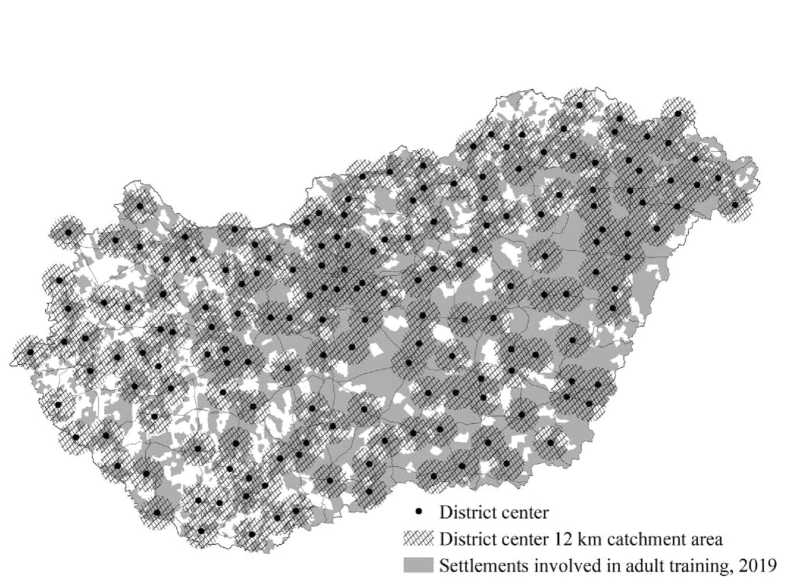
Fig. 4. 12 km catchment area of adult training on-site and district centers in Hungary (2010, 2019) Note. Compiled by the author based on: [OSAP 1665 ...].
Local Moran I statistics were positively autocorrelated in the study area. 0.009584 Moran index obtained in the spatial autocorrelation study of the proportion of participants in adult education in 2010 ( z -score = 3.089336, p -value = 0.002006) and 0.005615 Moran index obtained in the spatial autocorrelation study of the proportion of adult education participants in 2019 ( z -score = 1.682851, p -value = 0.092404) showed a positive autocorrelation. Both years examined showed a similar picture in the cluster analysis. In both years, low-high clusters were in the majority, which appeared mostly in the settlements surrounding the county capitals. Low-low clusters were most prevalent in the western part of the country, but their number showed high growth by 2019. In the eastern part of the country, almost only in Borsod-
Abaúj-Zemplén county were characteristic of the peripheral areas. High-High clustering was present in the eastern and central parts of the country, located near the county seats. High-low clusters appeared only in the western part of the country in both years studied (Fig. 5).
In the study of the spatial autocorrelation with the square value of the distribution ratio of the participants in adult education per settlement (Herfindahl – Hirschman index), clusters appeared in both years. Local Moran I statistics were negatively autocorrelated in the study area. –0.002596 Moran index ( z -score = –5.722225, p -value = = 0.000000) obtained in the spatial autocorrelation study of the proportion of participants in adult education in 2010 and –0.002496 Moran obtained in
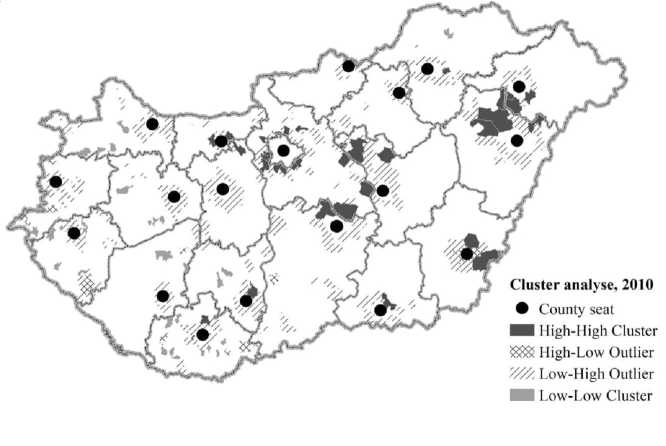
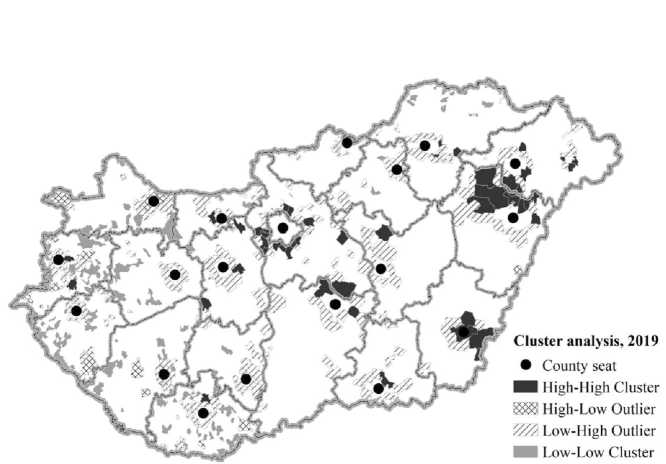
Fig. 5. Cluster analysis of adult training in Hungary (2010, 2019)
Note. Compiled by the author based on: [OSAP 1665 ...].
the spatial autocorrelation study of the proportion of participants in adult education in 2019 index (z-score = –6.828016, p-value = 0.000000) showed a positive autocorrelation. Given a z-score of –6.82801573633, there is less than a 1% probability that this scattered sample may be a random random result. The settlements with county seats and surrounding the capital showed low-high clustering in both years. Low-low clusters were typical in Western Hungary in both years. No high-high clusters were present in this type of study and high-low clustering was also found in only two settlements (Fig. 6).
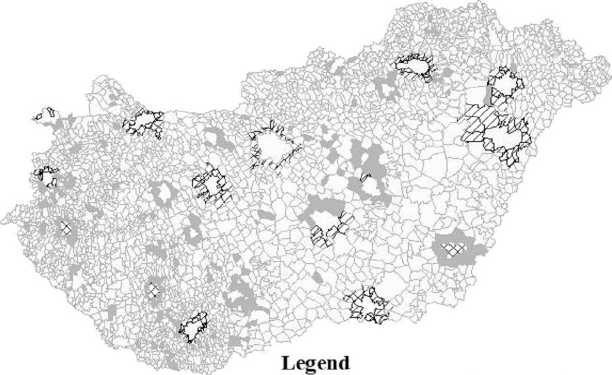
Ouster analysis HHI index, 2010
ZU Not Significant ^Я High-High Cluster Й221 High-Low Outlier VZA Low-High Outlier ^H Low -Low Cluster
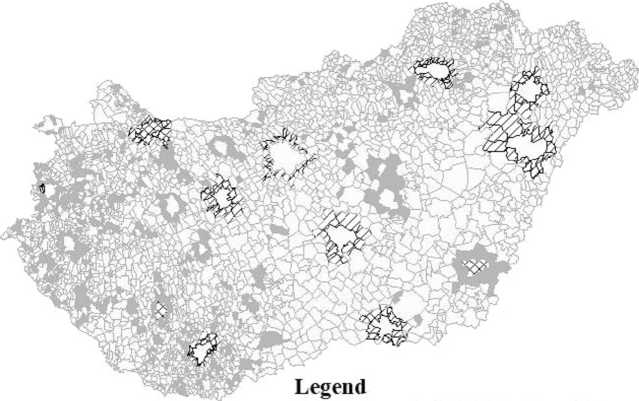
Cluster analysis HHI index, 2019
I Not Significant ■■High-High Cluster 553 High-Low Outlier L22I Low-High Outlier
Low-Low Cluster
Fig. 6. Examination of the] Herfindahl – Hirschman index and cluster analysis of adult training in Hungary (2010, 2019) Note. Compiled by the author based on: [OSAP 1665 ...].
During the Hotspot analysis of the examined territorial unit, I examined the ratio of adult education to the resident population.
The analysis revealed that a larger number of HotSpots developed in 2010 than in 2019. In 2010, hot spots appeared in the agglomeration of Budapest and Kecskemét in Central Hungary, between Nyíregyháza and Debrecen in Eastern Hungary, and in the settlements surrounding Lake Balaton in Western Hungary. In 2019, hot spots appeared in Eastern Hungary, Borsod-Abaúj-Zemplén county, along the two main roads connecting the county seat (Miskolc) with Slovakia, in Hajdú-Bihar county, and in Western Hungary in Baranya and Vas counties (Fig. 7).
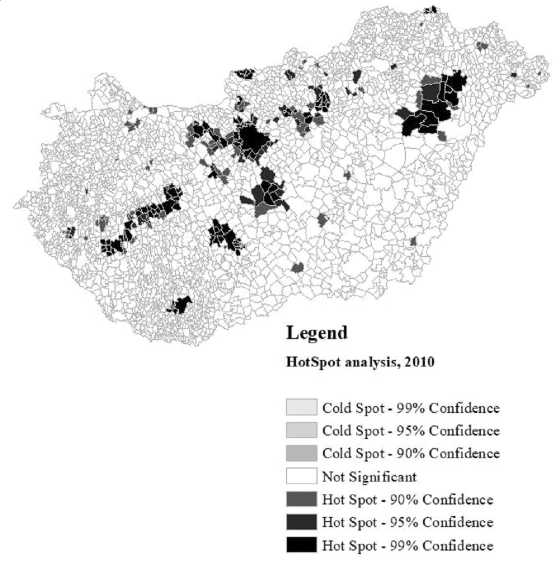
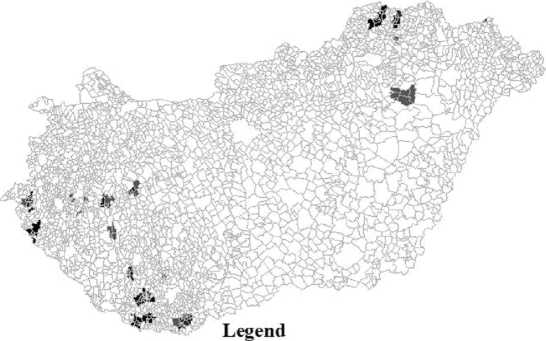
HotSpot analysis, 2019
Cold Spot - 99% Confidence Cold Spot - 95% Confidence Cold Spot - 90% Confidence
I Not Significant
1^1 Hot Spot - 90% Confidence
Ш Hot Spot - 95% Confidence ^B Hot Spot - 99% Confidence
Fig. 7. Examination of the HotSpot analysis of adult training in Hungary (2010, 2019) Note. Compiled by the author based on: [OSAP 1665 ...].
Conclusion
The composition of the Hungarian adult education age group has changed significantly in the two years examined. By 2019, people over the age of 60 have appeared in training, setting an example of the idea of lifelong learning. Women’s willingness to learn was higher during the period analyzed.
Over the 10 years, the number of settlements supporting the organization of adult education courses increased by 700 settlements.
Most of the research methods showed that the concentration of Budapest is outstanding in the country, followed by the county capitals, which had a focus of more than two-thirds for the participants. Trainings were available in all district centers in the country, further improving the availability of trainings. The training sites were mostly developed along the main roads.
Raising the 12-kilometer catchment area of the district centers, areas lacking adult education were outlined. Mostly in the border rural areas and in Western Hungary in the southern part of Lake Balaton, affecting 6 counties.
The autocorrelation analysis revealed that the ability of adult education participants to extract to county seats from the catchment area ofsettlements. In terms of the proportion of participants in adult education relative to the resident population, declining HotSpots developed by 2019, which could be found along the main routes.
From the point of view of the countryside, there can be progress in terms of achieving training, but the places of unskilledness can lead to further depopulation of rural areas.
Список литературы Regional distribution of adult education in Hungary (2010, 2019)
- 2013. évi LXXVII. törvény a felnőttképzésről. URL: https:// net.jogtar.hu/jogszabaly?docid=a1300077.tv.
- Anselin L., 1995. Local Indicators of Spatial Association. LISA Geographical Analysis, no. 27 (2), pp. 93-115.
- Benedek A., Csoma Gy., Harangi L., 2002. Felnőttoktatási és képzési lexicon A-Z. Budapest, Szaktudás Kiadó Ház. 568 p.
- Benedek A., Lőrincz É., 2016. Szakképzés és felnőttképzés: új rációk és emóciók a XXI. század elején. A felnőttképzésről három generáció nézőpontjából. Budapest, Magyarország, Magyar Pedagógiai Társaság, pp. 73-85.
- Egri Z., 2017. Magyarország városai közötti egészségegyenlőtlenségek. Területi Statisztika, no. 57 (5), pp. 537-575. DOI: 10.15196/TS570504.
- Európai Bizottság, 2000. Memorandum az egész életen át tartó tanulásról. Európai Közösségek Bizottsága, Brüsszel, október 30, 1832. 9 p.
- Farkas É., 2019. Adult Learning Is Key in the Adaptation to the Economic and Social Effects of the Fourth Industrial Revolution. Between Global and Local: Adult Learning and Communities Network: Learning and Living in Diverse Communities. University of Pécs, Hungary, pp. 18-27.
- Hajdú D., Koncz G., 2020. Álláskeresők támogatott felnőttképzésében résztvevők vizsgálata Borsod- Abaúj-Zemplén megyei helyszíneken. STUDIA MUNDI – ECONOMICA, vol. 7, no. 1, pp. 2-11. DOI: 10.18531/Studia.Mundi.2020.07.01.2-11.
- Heckman J.J., 2011. The American Family in Black & White: A Post-Racial Strategy for Improving Skills to Promote Equality. Dćdalus, the Journal of the American Academy of Arts & Sciences, vol. 140, no. 2, pp. 70-89.
- Heckman J.J., Masterov D.V., 2007. The Productivity Argument for Investing in Young Children. Review of Agricultural Economics, vol. 29, no. 3, pp. 446-493.
- Komarek L., 2012. A magyar ipar makroszintû specializációjának kérdései. PhD értekezés. Nyugatmagyarországi Egyetem Közgazdaságtudományi Kar Széchenyi István Gazdálkodás- és Szervezéstudományok Doktori Iskola, Sopron. 89 p.
- Koncz G., Szűcs A., 2017. A szolgáltató tevékenységek jelenléte és területi koncentrációja Heves megyében. LIX. Georgikon Napok: A múlt mérföldkövei és a jövő kihívásai: 220 éves a Georgikon. Keszthely, Magyarország, pp. 272-281.
- Koncz G., Szűcs A., Nagyné Demeter D., 2018. A gazdaság térszerkezetének változásai Észak-Magyarországon az ezredforduló után. Jelenkori Társadalmi és Gazdasági Folyamatok, no. 13 (1-2), pp. 139-149.
- Kozma T., 2000. Negyedik fokozat? INFOTársadalomtudomány, no. 49 (október), pp. 61-74.
- Lakner Sz., 2016. A felnőttképzési módszerek jelentősége és kihívásai az emberi erőforrás fejlesztési gyakorlatban. Pécs, Magyarország, Lartco Consulting Kft. 159 p.
- McMahon W.W., 2000. The Measurement of Externalities, Non-Market Effects, and Trends in the Returns to Education. The Appraisal of Investments in Educational Facilities. European Investment Bank/OECD. Paris, OECD.
- Polónyi I., 2019. Vigaszág vagy királyi. Educatio, no. 28 (4), pp. 767-782. DOI: 10.1556/2063.28.2019.4.8.
- Polónyi I., 2018. A felnőttképzés megtérülései. A felsőoktatási lifelong learning társadalmi és gazdasági haszna: kutatás – fejlesztés – innováció. Debrecen, Hungary. MELLearN Felsőoktatási Hálózat az életen át tartó tanulásért Egyesület, pp. 99-113.
- Schultz Th.W., 1983. Beruházások az emberi tőkébe. Budapest, Közgazdasági és Jogi Kiadó. 300 p.
- Tóth G., 2014. Térinformatika a gyakorlatban közgazdászoknak. Miskolci Egyetem, Miskolc. 107 p.
- Tóth J., 2017. Felnőttképzéssel a társadalmi kirekesztettség ellen? KÖZJAVAK, no. 3:3, pp. 21-26.
- Zachár L., 2003. Felnőttképzés, munkaerőpiaci képzés tervezése. Pécs, Magyarország: Pécsi Tudományegyetem Természettudományi Kar Felnőttképzési és Emberi Erőforrás Fejlesztési Intézet. 147 p.
- Zachár L. A felnőttképzés rendszere és főbb mutatói. URL: http://ofi.hu/felnottkepzes-rendszere-es-fobbmutatoi.
- OSAP 1665 Statisztikai Felület. Pest Megyei Kormányhivatal. URL: osap.mer.gov.hu.

